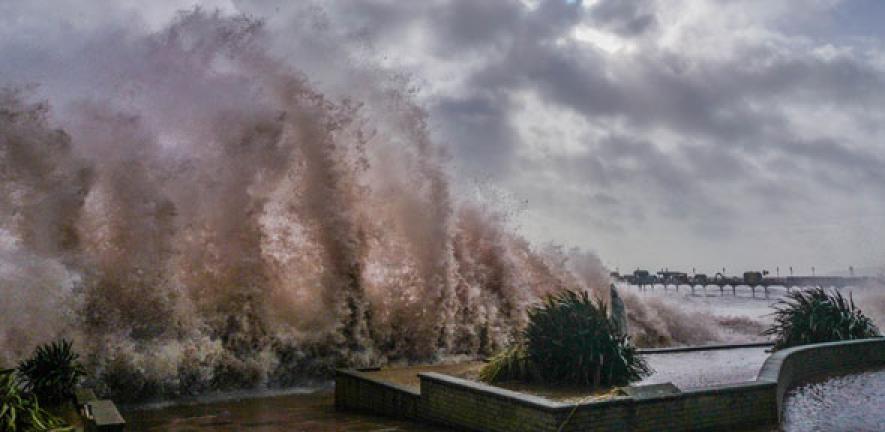
Professor Tom Spencer from Cambridge’s Department of Geography and Professor Gerd Masselink from the University of Plymouth say evidence suggests there should be far stricter controls on coastal developments.
Professor Tom Spencer from Cambridge’s Department of Geography and Professor Gerd Masselink from the University of Plymouth say evidence suggests there should be far stricter controls on coastal developments.
In October 2018, a stark report suggested that current methods being used to protect England’s coastal communities are ‘not fit for purpose’.
The Committee on Climate Change’s Managing the coast in a changing climate report showed that between 2005 and 2014, over 15,000 new buildings were built in coastal areas at significant risk of coastal flooding and/or erosion.
However, if the government meets its ambitious housing targets, up to 90,000 homes built in the next five years might be in areas of significant annual flood risk from all sources of flooding, including coastal flooding.
Practically every winter we are reminded of how dynamic our coastline is. And many of us see at very close quarters how vulnerable many communities in the UK are to coastal flooding and erosion.
But by the time summer arrives, the need for a wide and deep debate as to how we deal with rising sea levels and potential future increases in maritime storminess around the UK coastline evaporates.
Our approach to coastal management issues is to react to failures of coastal defences, either natural or man-made, rather than proactively working towards future-proofing our coastline.
Much of the UK coastline is already eroding, as testified by the dominance of coastal cliff scenery. But coastal erosion and flooding, and consequent damage to infrastructure, disruption of services and modifications to the coastal landscape will become more common over the next century due to climate change.
Specifically, rising sea levels will increase the probability of extreme coastal water levels and this could be exacerbated by potentially larger and more frequent extreme waves due to changes to the wave climate.
At the same time, our coastal zone is far from natural, with numerous clifftop properties and extensive development at the back of beaches, on top of dunes and in low-lying coastal valleys. It is obvious that coastal communities are facing significant future challenges.
Much existing coastal development took place when our understanding of coastal dynamics was limited and when climate change, and its consequences for the coast, was not yet a reality.
That development is already under threat, and the scale of the threat will only increase. Dealing with this issue requires a balanced consideration of the various adaptation strategies, ranging from ‘hard’ coastal protection such as sea walls to more sustainable solutions such as supplementing the amount of sand and gravel on our beaches, and managed realignment.
There will always be locations where only hard coastal defences will do.
But if we wish to avoid piling ever-increasing costs – in both financial and environmental terms – on future generations, we need a more sophisticated, integrated discussion of zoning (to avoid building in high-risk zones).
It may be stating the obvious, but a relatively easy win is to avoid more development in the dynamic coastal zone unless it is absolutely essential.
The concept of Coastal Change Management Areas (CCMAs) can play a key role here.
The National Planning Policy Framework (NPPF) requires councils to identify CCMAs where rates of shoreline change are expected to be significant over the next 100 years, taking account of climate change.
The first local plan to make use of CCMAs to inform coastal planning is in Cornwall, where the Newquay Neighbourhood Plan (NNP) is currently under consultation.
The NNP recommends that proposals for development in CCMAs should only be supported where they are for “small, temporary structures that will not add to the erosion risk”, and rules out residential development.
Proposals for redevelopment, enlargement or extension of existing buildings that fall within the exclusion zone, and proposals to change the use of existing buildings into residential usage, will not be supported either.
In the NNP, the landward limit of CCMAs represents the estimated 100-year erosion line with an additional buffer of 10 metres. Another 2m buffer zone is added if the coastal path is located within the CCMA.
Continued investment into the coastal zone will reduce the natural capability of the coast to respond to hazards, while at the same time passing the financial burden of protecting such coastal development onto future generations.
In order to future-proof our dynamic coast, we need to implement an appropriate buffer zone to inform coastal planning decisions, and these buffer zones will need to be site-specific and science-based.
They would also require regular updating in light of new data, understanding and predictions of climate change and its consequences.
The Committee on Climate Change’s report has demonstrated the scale of future potential problems, and our own research heavily supports their findings.
By implementing a CCMA-informed policy that is consistent on a national scale, potentially with the policy outlined in the NNP as a blueprint, we can better protect our coastlines now and for future generations.
A bold response to the world’s greatest challenge
The University of Cambridge is building on its existing research and launching an ambitious new environment and climate change initiative. Cambridge Zero is not just about developing greener technologies. It will harness the full power of the University’s research and policy expertise, developing solutions that work for our lives, our society and our biosphere.

The text in this work is licensed under a Creative Commons Attribution 4.0 International License. Images, including our videos, are Copyright ©University of Cambridge and licensors/contributors as identified. All rights reserved. We make our image and video content available in a number of ways – as here, on our main website under its Terms and conditions, and on a range of channels including social media that permit your use and sharing of our content under their respective Terms.




